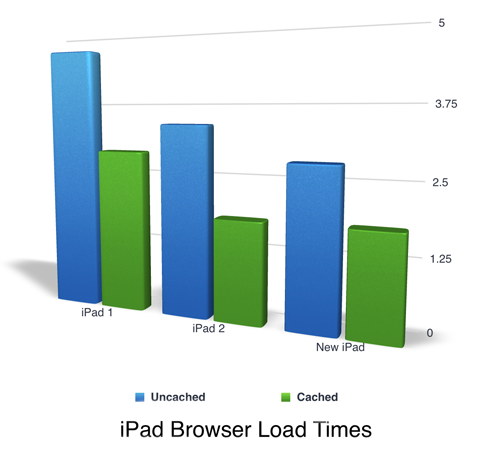Safari on New iPad 18% Faster than iPad 2
Thinking about getting the latest new iPad? One of the main activities for the iPad is web browsing, so we thought it would be fun to see how all three iPad models stacked up in the web page load time race.
Which Web Pages? These websites were picked for no particular reason other than we use them regularly and are likely representative of the browsing habits of a large number of our readers.
www.amazon.com
www.apple.com
www.facebook.com
www.microsoft.com
www.wikipedia.org
www.yahoo.com
Static vs. Real-World Testing
Typically browser performance is reported by running static benchmark tests that measure in a highly controlled way with few variables. Unfortunately, when you or I sit down to browse the news or check out the latest Facebook postings, we will not have a fixed set of carefully structured data files. Real world testing gives a much better approximation of the day-to-day user’s experience. Site quirks and flaws are more likely to show up under these conditions. The downside is repeatability, as this approach does leave the results vulnerable to stochastic network bandwidth and latency changes. In our 2007 browser assessment we established that test results were consistent between local network copies of sites and the public sites, and thus we are confident that tests measuring browser load times over public networks are reasonably accurate.
Caching Effects
Web browsers cache website content in a variety of complex ways in order to speed up performance, which means when you visit a website that isn’t cached the load times typically are much slower. Caching is accomplished by storing the content locally so the browser doesn’t have to re-download content over a network. This is easy on a computer with a hard drive, but more complicated on an iPad with limited storage. Apple hasn’t made the caching behavior of Safari for iOS public so its anyone’s guess as to how often you’ll be pulling web content from cache, but it presumed that fewer resources are cached compared to a desktop browser.
Test Setup
All testing was done over Wi-fi with a business-grade internet connection. Web page load times were measured three times per iPad version per website to establish reliability, and the median values used to measure overall performance.
Conclusions
The first thing to notice is there’s a clear progression in performance: each new version of the iPad is clearly faster in rendering uncached websites. Look closer, though, and you’ll notice that the performance increase has slowed. The iPad2 was 28% faster than the original iPad, but the new iPad is only 18% faster than the iPad2. The 4.7 second load times on the original iPad are really looking slow now compared to the new iPad, which is 40% faster.
Even so, the new iPad is faster, right? For uncached websites, sure, but for sites that are already cached we found a median web page load time of 1.8 seconds for both the iPad2 and new iPad. What does this mean? It would appear that the load time optimizations for cached websites aren’t affected by the updated rendering engine in the new iPad. If you mostly access the same couple of websites on your iPad you’ll be unlikely to see much of a performance increase by switching from an iPad2 to the new iPad.

